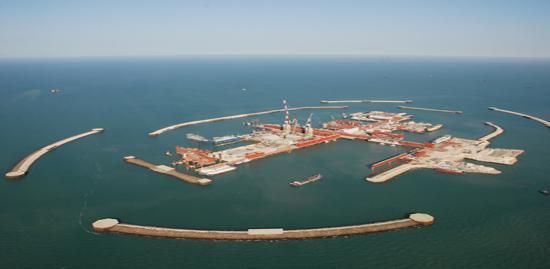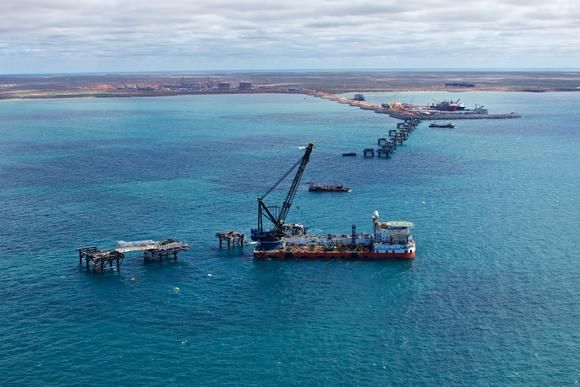Seven years and $24 billion.
No, that isn't the price tag for a major project coming online. That's how late and how much over budget the giant Kashagan oil project in the Caspian Sea ended up being before it started flowing this week. Bringing in multiple stakeholders on these complex, challenging megaprojects in the energy industry has become a pretty nasty cocktail for those involved. Are the blunders with Kashagan an exception or the rule when it comes to these major projects? Let's look at some other major projects going on right now to see what Big Oil has in store for its next big move.
Big bucks, little bang
 Source: Eni Media Relations.
Source: Eni Media Relations.
The project to bring the world's largest oil discovery in the past 30 years has so far been mired in delays, cost overruns, and overall headaches for pretty much everyone involved. With the current bill standing at $48 billion for a paltry production of 375,000 barrels per day divided up among seven companies, the project is averaging a capital cost of $80,000 per barrel of production capacity. To put that in perspective, conventional oil projects in Saudi Arabia today are about one-fifth of that amount.
ExxonMobil, a company that prides itself as one of the best capital
allocators in the business -- estimates that it will take beyond 2040 for this project to make a reasonable rate of return. In fact, both it and partner Royal Dutch Shell have repeatedly threatened to pull out of the project because of contentious negotiations with the Kazakh government, delays, and a lack of operational control over the project.
Trouble Down Under
Some might say that the troubles with the Kashagan project are rooted deeply with the negotiations with the national government. Even in regions where there is a more friendly operating environment, though, companies are still struggling to keep projects on budget. Case in point: Chevron's Gorgon project in Australia.
 Source: Chevron Media Relations.
Source: Chevron Media Relations.
When Chevron and its partners Exxon and Shell gave this mega-LNG project the green light in 2009, the group estimated that the final bill would be about $37 billion. Eventually, though, currency rate changes, bad weather, and ballooning labor costs have pushed the project to more than $52 billion. Fortunately for Chevron, which has a nearly 50% stake in the project, construction is about 67% complete, and the delays on the project can be measured in months and not years. Once operational, it will represent about two-thirds of the company's production growth target for 2017. The question remains, though, whether the flood of new LNG export facilities coming online between now and the end of the decade will erode at the pricing advantage the project had when it was established.
The next victim
The next mega-oil project has yet to come online. But when Petrobras starts
gathering assets in the upcoming pre-salt auction, it's almost certain that the project will run into cost overruns and delays. One of the big issues with operating in Brazil is that the government mandates that a certain percentage of parts and labor come from domestic sources, which has led to inflated costs. Rig company Diamond Offshore has stated that it adds almost 15% to dayrates for rigs and drillships destined for Brazil to cover the higher labor associated with working there.
Also, with the government mandating that Petrobras be the primary operator in the entire field and have a minimum 30% working interest in each project, any oil company that wants to be part of the field will have to submit to having Petrobras call the shots. Petrobras has plans to spend more than $230 billion alone to develop these fields, which dwarfs almost any other major project planned today. If we see the cost overruns in the Brazilian offshore as we've seen in the other parts of the world, then the company could be in for some financial pain.
What a Fool believes
There is still lots of oil out there, but it's in increasingly challenging environments. Getting several players involved may help spread the costs out so no single entity bears the burden, but it also makes it more difficult to make investment decisions. Ultimately, the high costs for these major projects will become more the rule rather than the exception as we continue to explore further offshore and deeper underground.
For investors looking at companies that have major projects on the books, look to see whether there's one company that is clearly the lead of the project and has the operational history of executing on these types of major projects. Such projects are more likely to remain on schedule, which should lead to a slightly more predictable outcome even if costs aren't what they were originally budgeted to be.
Founded in 1993 in Alexandria, Va., by brothers David and Tom Gardner, The Motley Fool is a multimedia financial-services company dedicated to building the world's greatest investment community. Reaching millions of people each month through its website, books, newspaper column, television appearances, and subscription newsletter services, The Motley Fool champions shareholder values and advocates tirelessly for the individual investor. The company's name was taken from Shakespeare, whose wise fools both instructed and amused, and could speak the truth to the king -- without getting their heads lopped off.
 В Атырау 0
В Атырау 0